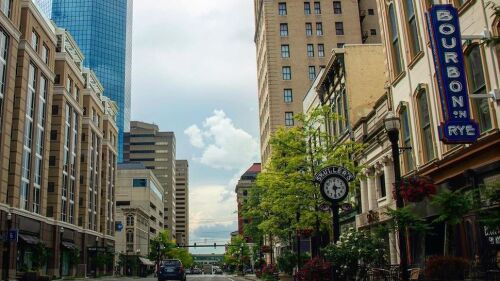When you see the pink + blue houses, you know you’ve entered what is known as Lexington’s oldest neighborhood. Gratz Park is more than just a great photo-op or community space — we’re taking you back 240+ years to the beginning.
The late 1700s: Era of Transylvania
Established in 1781, the historic district was originally called Outlot No. 6 when the city was first being plotted by the Virginia Assembly. Fast forward to 1793, Transylvania Seminary purchased what they then deemed the “College Lot” — set to be the site of its Lexington campus where private residences began forming along the perimeter.
In 1816, the main building for the campus was built after being designed by Kentucky’s first architect — Matthew Kennedy. A fire destroyed the campus in 1829, leading Transylvania to move to its current residence in 1833.
Establishing Gratz Park in the 1800s
The neighborhood’s most notable resident, Benjamin Gratz, moved in on the corner of Mill + New Streets in 1824. As an early businessman, his legacy includes being a founder of Lexington’s first public library and the Lexington and Ohio Railway.
During the Civil War, the area was known for being a parade ground and bivouac shelter for Union + Confederate troops. Pro tip: Head to the Hunt Morgan House on North Mill Street to check out the Alexander T. Hunt Civil War Museum.
After the war, the grounds were left unattended — until Benjamin Gratz’ son, Howard, sold subscriptions of the Kentucky Gazette to fund improvements from 1875 to 1876. This initiative was what helped fence in the area and even brought the iconic arches (donated in 1879).
On Sept. 4, 1876, the site was named Centennial Park — but was later changed to Benjamin Gratz Park. Howard Gratz continued to care for the neighborhood, and can be the one to thank for many of the park’s tulip poplars. The Gratz family occupied their home until 1984.
What could have been: The Olmsted Plan
Gratz Park could have looked a lot different than it does now. In 1909, sons and successors of Frederick Law Olmsted — known as being the founder of American landscape architecture — created a vision for the park based on Olmsted’s philosophies adopted across the nation.
Playgrounds, an arbor + gazebo style structure, and French-styled parterre garden were planned for the park but never implemented. However, in 1917, an agreement between Anderson Gratz and the city guaranteed development couldn’t happen within the green space — sparked by the development of the Carnegie Library.
Gratz Park was designated as Lexington’s first local historic district in 1958 + listed on the National Register of Historic Places in 1979.
The path to now
2006 brought more recognition as Gratz Park became the nation’s first seven Preserve America Neighborhoods. To continue upkeep of the district, the Gratz Park Neighborhood Association used the $90,000+ matching grant and created a master plan that is still referenced today.
Now, there’s still a lot of history to uncover inside the halls of the homes that surround the park — all designed in different styles, from Greek Revival to Victorian-era. There’s even some well hidden secrets, too. In 2012, homeowners opened up their private gardens for the first time, allowing residents to take part in an exclusive tour through history.

Seasons may come and go, but the history remains the same.
Photos via @abbieroden, @silashouse, @carlinjrus + @deborahback1
Ways to continue learning
Local photographer Bob Willcutt + UK professor Jeremy D. Popkin published “Gratz Park: The Heart of Lexington” earlier this year. The book is a compilation of photographs and historical essays telling the real-life stories lived within Gratz Park.
You can also quite literally walk through history with the help of this walking tour mapped out by the Lexington Public Library. Bring headphones, because during the 0.4-mile stroll, you can listen to audio clips that cover the neighborhoods history — from the Gratz Park Fountain to The Kitchen (the only surviving building from Transylvania’s original Lexington campus).












